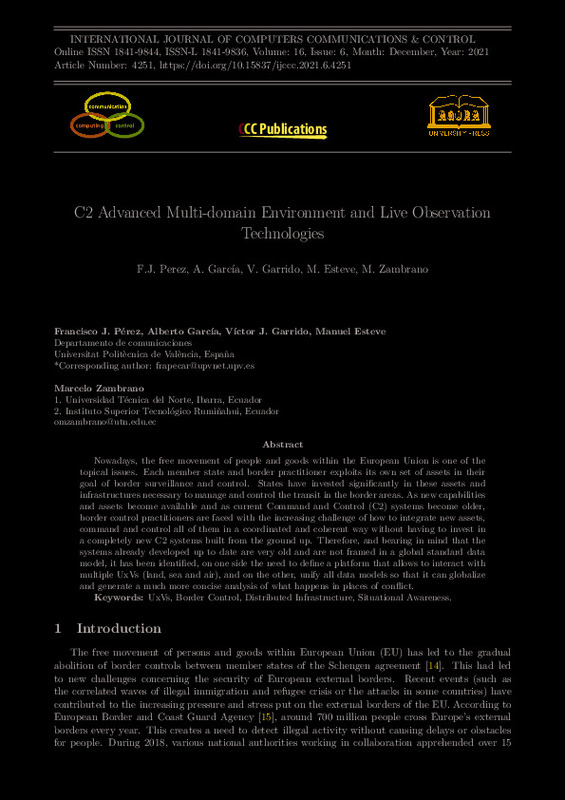JavaScript is disabled for your browser. Some features of this site may not work without it.
Buscar en RiuNet
Listar
Mi cuenta
Estadísticas
Ayuda RiuNet
Admin. UPV
C2 Advanced Multi-domain Environment and Live Observation Technologies
Mostrar el registro sencillo del ítem
Ficheros en el ítem
| dc.contributor.author | Pérez-Carrasco, Francisco José
|
es_ES |
| dc.contributor.author | García-García, Alberto
|
es_ES |
| dc.contributor.author | Garrido-Peñalver, Víctor Javier
|
es_ES |
| dc.contributor.author | Esteve Domingo, Manuel
|
es_ES |
| dc.contributor.author | Zambrano, Marcelo
|
es_ES |
| dc.date.accessioned | 2023-11-06T19:02:48Z | |
| dc.date.available | 2023-11-06T19:02:48Z | |
| dc.date.issued | 2021-12 | es_ES |
| dc.identifier.issn | 1841-9836 | es_ES |
| dc.identifier.uri | http://hdl.handle.net/10251/199382 | |
| dc.description.abstract | [EN] Nowadays, the free movement of people and goods within the European Union is one of the topical issues. Each member state and border practitioner exploits its own set of assets in their goal of border surveillance and control. States have invested significantly in these assets and infrastructures necessary to manage and control the transit in the border areas. As new capabilities and assets become available and as current Command and Control (C2) systems become older, border control practitioners are faced with the increasing challenge of how to integrate new assets, command and control all of them in a coordinated and coherent way without having to invest in a completely new C2 systems built from the ground up. Therefore, and bearing in mind that the systems already developed up to date are very old and are not framed in a global standard data model, it has been identified, on one side the need to define a platform that allows to interact with multiple UxVs (land, sea and air), and on the other, unify all data models so that it can globalize and generate a much more concise analysis of what happens in places of conflict. | es_ES |
| dc.description.sponsorship | This work has been performed under the H2020 740736 project CAMELOT, which has received funding from the European Union's Horizon 2020 Program. This paper reflects only the authors' view, and the European Commission is not liable to any use that may be made of the information contained therein. | es_ES |
| dc.language | Inglés | es_ES |
| dc.publisher | Agora University of Oradea | es_ES |
| dc.relation.ispartof | International Journal of Computers Communications & Control | es_ES |
| dc.rights | Reconocimiento - No comercial (by-nc) | es_ES |
| dc.subject | UxVs | es_ES |
| dc.subject | Border Control | es_ES |
| dc.subject | Distributed Infrastructure | es_ES |
| dc.subject | Situational Awareness | es_ES |
| dc.subject.classification | INGENIERÍA TELEMÁTICA | es_ES |
| dc.title | C2 Advanced Multi-domain Environment and Live Observation Technologies | es_ES |
| dc.type | Artículo | es_ES |
| dc.identifier.doi | 10.15837/ijccc.2021.6.4251 | es_ES |
| dc.relation.projectID | info:eu-repo/grantAgreement/EC/H2020/740736/EU | es_ES |
| dc.rights.accessRights | Abierto | es_ES |
| dc.contributor.affiliation | Universitat Politècnica de València. Escuela Técnica Superior de Ingenieros de Telecomunicación - Escola Tècnica Superior d'Enginyers de Telecomunicació | es_ES |
| dc.contributor.affiliation | Universitat Politècnica de València. Departamento de Comunicaciones - Departament de Comunicacions | es_ES |
| dc.description.bibliographicCitation | Pérez-Carrasco, FJ.; García-García, A.; Garrido-Peñalver, VJ.; Esteve Domingo, M.; Zambrano, M. (2021). C2 Advanced Multi-domain Environment and Live Observation Technologies. International Journal of Computers Communications & Control. 16(6):1-17. https://doi.org/10.15837/ijccc.2021.6.4251 | es_ES |
| dc.description.accrualMethod | S | es_ES |
| dc.relation.publisherversion | https://doi.org/10.15837/ijccc.2021.6.4251 | es_ES |
| dc.description.upvformatpinicio | 1 | es_ES |
| dc.description.upvformatpfin | 17 | es_ES |
| dc.type.version | info:eu-repo/semantics/publishedVersion | es_ES |
| dc.description.volume | 16 | es_ES |
| dc.description.issue | 6 | es_ES |
| dc.relation.pasarela | S\451728 | es_ES |
| dc.contributor.funder | COMISION DE LAS COMUNIDADES EUROPEA | es_ES |
| dc.contributor.funder | Universitat Politècnica de València | es_ES |
| upv.costeAPC | 603,2 | es_ES |








